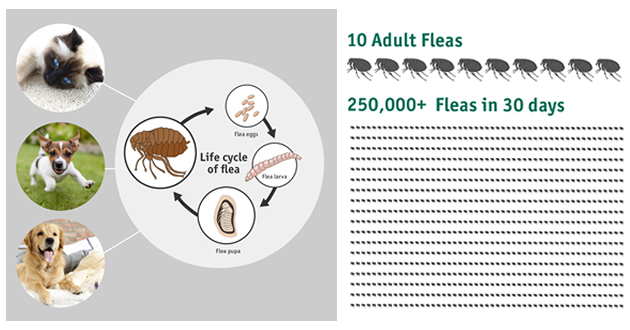Do you struggle with keeping your pet flea free in the warmer months? Don’t be alarmed because you are not the only one! During the warmer months, fleas are getting ready to breed and infest the environment and our pets and make their lives itchy and uncomfortable. The answer to a flea free pet is simple; prevention. Understanding more about fleas and the way they work might also unlock some answers as to why you may struggle keeping fleas off your pets.
What are fleas?
Fleas are tiny dark brown parasitic insects that infest the coat and skin of pets. They have an amazing skill allowing them to jump up to 150 times their own length. That’s like a human jumping over 300 metres. Their remarkable jumping skills allow them to transit easily between hosts and the surrounding environment.
How do you tell if your pet has fleas?
One of the first signs of a flea infestation is that your pet will be scratching and seem quite irritated. On closer examination you could find adult fleas in the coat or at the base of the fur on the skin. You may even find flea dirt that looks like small black specks of grit, similar to finely ground pepper. This is actually digested dried blood. 10 adult fleas can multiply to more than 250,000 fleas in only 30 days.
How do pets get fleas?
Flea eggs can remain dormant for astonishingly long periods of time under a variety of conditions. They lay dormant in the garden, or in your carpet and furniture, until they are able to hatch and hitch a ride. They jump great distances to find a host and travel on pets and even on people
Fleas are the number one cause of skin disease in pets and can cause problems ranging from simple itchiness to weeping sores, scaly skin and a strong smell. In severe cases they can cause anemia. Some dogs and cats are even allergic to flea bites or their saliva (a condition known as Flea Allergy Dermatitis), where one bite sets off a horrible reaction. All skin conditions require veterinary treatment. We advise you to visit your local Greencross Vets to learn more on how to treat and prevent fleas.
Why is it important to treat and prevent fleas?
Fleas are the number one cause of skin disease in pets and can cause problems ranging from simple itchiness to weeping sores, scaly skin and a strong smell. Some dogs are even allergic to flea bites or their saliva (a condition known as Flea Allergy Dermatitis), where one bite sets off a horrible reaction. All skin conditions require veterinary treatment. As you might expect fleas carry bacteria that can be harmful to humans as well as their pets making it harmful for the whole household, we advise you to visit your local Greencross Vets to learn more on how to treat and prevent fleas.
Why do fleas spread so quickly?
Fleas breed at an enormous rate. The fleas you see on your dog represent only 5-10% of the fleas in the environment. The rest of the population is represented in the egg and larval stages found in your carpets, furniture, bedding and garden.
The lifecycle explained…
- 5% of fleas will be found on your pet, a staggering
- 95% of fleas live as eggs, larvae or pupae in the environment
- For effective flea control it is essential to break the lifecycle in the environment
 |
Adult Fleas: jump onto your dog or cat, feed on their blood and then start laying eggs.
Eggs – one female lays up to 50 eggs per day, they drop off in carpets and bedding before hatching.
Larvae – the hatched eggs release larvae which move away from light, deeper into carpets and under furniture before developing into pupae. The larvae feed on organic debris and at this stage can consume tapeworm eggs, allowing them to become an intermediate host for the development of tapeworms.
This life cycle can take as little as 2-3 weeks and as long as 12 months. To rid your household from fleas, you must break this cycle. Prevention is the key to flea control. There are many different flea products available today and the options can be confusing. Not all products are suitable for pets due to the variation in body weight, ages and owner capabilities.
How do you protect your pet from fleas?
When undertaking flea control you have to consider the various stages of the lifecycle. In severe infestations, it is strongly recommended to treat both the pet (all pets at home) and the environment (inside and outside) Eliminating fleas using a multi-pronged approach is vital to gain the upper hand in the fight against fleas.
Products to rid fleas on your pet
Advanced effective treatment – “Spot on” drops are very easy to use
Daily Oral medications – Daily tablets for instant relief and a quick knockdown are available but generally the longer acting products are preferred
Longer acting Tablets or chews – Work as an effective control for fleas, hence stopping the life cycle process. Depending on the product, they can last 1-3 months
Shampoos & rinses – Kill fleas that are on your pet but offer little residual protection.
Control the environment – Adopt control strategies including: Vacuum the carpet 2-3 times a week to remove eggs, wash pets blankets weekly (in the washing machine), spray the house, kennels and yards with an adult flea killer, fog the house to prevent larvae developing.
Your pet’s skin…
If your pet is scratching or has any skin damage, then it is best to have a veterinary check. It will likely require more than flea control alone to resolve the itch. If your pet does require flea control products, our Greencross veterinary and nursing team are fully trained in flea management and can assist in choosing a product most suitable for your pet.

 Greencross Vets
Greencross Vets 









